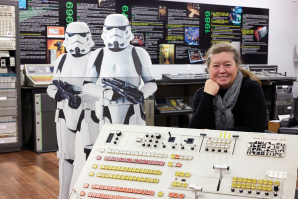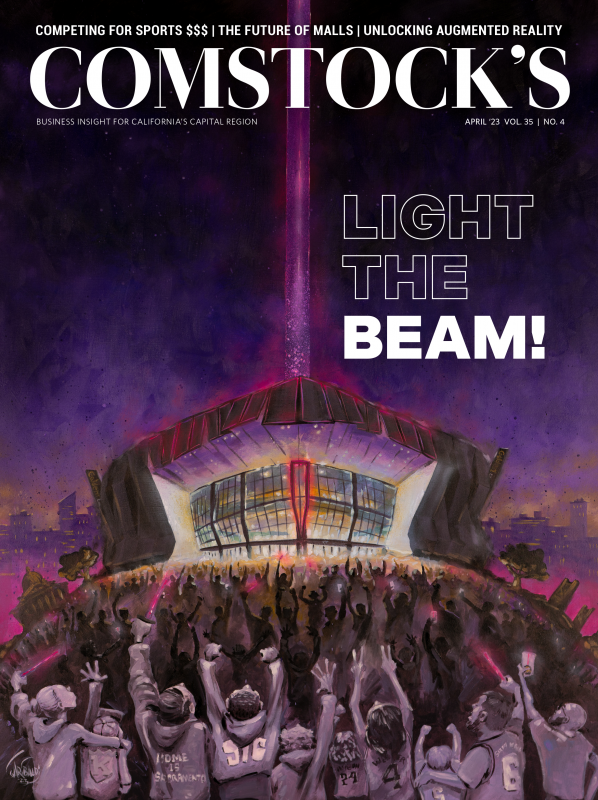In the fall of 2018, Will Brown told a Facebook representative he wasn’t a fan of clown noses.
Facebook had recently launched Spark AR, a free program where users can create and share augmented reality experiences. But in San Francisco at AfroTech, an annual conference that connects Black innovators and tech companies, the rep spoke of plans to improve their popular filters, such as clown noses and rabbit ears. Brown fidgeted in the room. To him, these upgrades were impractical, gimmicky, useless to brands looking to build real engagement. And he let his thoughts be known in front of everybody.
“In the middle of the lecture, I said, ‘Where do you see AR going in the next five years?’” he recalls. He then shared his vision of the future: A world of AR focused less on filters and more on function — technology that enables users to unlock exclusive content, he says, “that strengthens brand messaging and proposition value.”
The rep looked stunned. The audience applauded. Many flocked to him afterwards to find out who this man was and what he did. At the time, Brown was in the early stages of his own business, InterApp. But after launching at SXSW 2019, his Sacramento-based AR startup, which allows creators to transform printed materials into interactive graphics, has raised $1.2 million in pre-seed funding. As of February 2023, there are 500 content creators on the platform.
“I think AR provides a unique engagement experience that you can’t get from other technologies,” Brown says. “With Facebook and Instagram, you’re on your phone and scrolling through content. But AR allows you to get your head up from your phone and interact with the world around you.”
Unlike virtual reality, which immerses users in an artificial environment, augmented reality superimposes information in the real world. This information can take the form of graphics, text, audio and other sensory inputs to enhance one’s experience. In recent years, AR apps have grown in popularity for businesses and consumers in different areas, such as shopping for furniture or home decor, trying on shoes or makeup. While holding up a phone or tablet to see a virtual object in the real world gives users a small glimpse into the possibilities, many believe wearables will ultimately take AR to the fully integrated next level.
But from creators to investors to users, the world of AR has always been a tricky one to get a handle on. Remember Google Glass? Ten years ago, the wearable headgear caught flack before it could find a market foothold. It wasn’t exactly clear who or what the smart glasses would be good for, and privacy advocates blasted the idea of wearers — nicknamed “glassholes” — recording people without permission.
Still, if you look at statistics, the AR technology takeover is coming. Recent data estimates 1.7 billion mobile AR devices worldwide by 2024. BIS Research forecasts the AR market reaching $198 billion in 2025 when it was only worth $3.5 billion in 2017. Gaming, obviously, will retain a sizable slice of the AR pie, but applications in health care, education and manufacturing might be the real game changers.
“We’re seeing some traction on some of those use cases,” says David Allen, a general partner at Moneta Ventures, who identifies promising enterprise companies, “but we need to make it more approachable for a broader array of people.”
What’s the use?
Reports show that bulky hardware is the biggest obstacle to AR adoption. The equipment is costly, early iterations clunky. For tech enthusiasts who like to tinker with shiny new toys, that might be good enough. But despite AR’s vast potential, the average consumer won’t spend hours trying to figure out how something works.
“The ability to sell ads in that space is going to be off the charts,” Allen says, “but will I have to wear a bulky headset?”
AR startups can and eventually will attract big bucks from investors, he adds, but right now, the technology is nascent. Given the right building blocks, he says, designers can create a better human-machine interface that brings the technology into broader uses. In education, this could look like a physics teacher who builds a digital 3D model that can spin in a classroom. In manufacturing, this could look like superimposed guides to assist with transit flow in a warehouse.
Will Brown is the CEO of InterApp.

“AR allows you to get your head up from your phone and interact with the world around you.”
Will Brown, CEO, InterApp
The development of optical imaging technologies will be a priority at the National Center for Interventional Biophotonic Technologies coming to UC Davis’ Aggie Square in 2024. Currently, physicians use CT scans, X-rays or MRIs prior to an operation to gather information and plan the procedure. New imaging technologies will provide real-time guidance during medical and surgical procedures. For instance, a surgeon might use AR goggles to analyze data during an operation to make better decisions that improve outcomes.
Brown first encountered AR in 2016, while visiting the Space Needle in Seattle. He recalls seeing circles — called “space spots” — on the floor around the Needle’s base and Observation Deck. Users who downloaded the Space Needle app could interact with these spots to see all sorts of images.
“You could be standing over a virtual glass floor with a jaw-dropping view of what’s 520 feet below,” reads a 2014 promo article. “Maybe you’ll find a life-sized Needle with colorful fireworks bursting everywhere. Capture your Space Spots discoveries using the built-in camera and share with friends and family!”
Ever since then, Brown has been a believer that AR could elevate the user-experience. “I said, ’I got to figure out how to bring this technology back to Sacramento,’” he says.
At the time, he ran a business printing marketing materials for startups and legacy businesses. But he thought he could add value and keep print relevant by integrating AR material for customers.
“My background wasn’t tech,” he says. “I come from a brick-and-mortar background: Customers come in, print what they need right then and there. But my advisors said, ‘If you want to be able to scale this concept, you have to make it a SaaS (software as a service).”
From that point, it was a winding road of pivoting and bootstrapping and, Brown says, “easily $25,000 lost due to empty promises.” Print shop owners and managers had no interest in AR, he says, but he randomly met a graphic designer who helped him realize InterApp’s true target audience: artists.
“Our strategy is to embed ourselves in a specific audience where AR can flourish,” Brown says. “We have a great collaboration system with people who draw, paint and do canvas prints. Most of them are influencers and the audience is receptive to what they’re doing.”
Granted, the concept of AR is hard to describe with words. But imagine going to an art show, where you’re prompted to point your camera phone at a wall painting. Suddenly, as you look through the camera, the art piece is no longer static, but a dynamic media experience that could be animated or 3D, which allows you to engage with it in a whole new way.
“We’re letting (artists) tell the story of how they’re utilizing InterApp and the benefits of that,” says Brown. “We’ve been able to tell their stories through video content we promote on IG, which generates more users for us. Having a unique strategy in that sense has been very effective.”
“COVID enabled more people to do things virtually, but stunted growth.”
Jon Gregory, partner and former organizer, Capital Region AR VR Accelerator
In Clarksburg, Bogle Family Vineyards used a strategy of blending AR technology with local lore. Over the years, reports have grown of a spooky figure at the winery. People have spoken about the feeling of being watched by this ghostly man, who wears blue jeans and muddy boots.
Using an app, wine lovers can unlock the mystery of this figure by aiming cameras at the label on Bogle’s Phantom wines. Since the app was specific to its Phantom brand, some were reluctant to download and keep the app, according to Paul Englert, vice president of marketing at Bogle. But it showed how much others, intrigued by the paranormal, would engage with the technology, which led to an extensive collection of videos and a ghost story writing contest.
According to Englert, “Phantom is a fun brand, and video, AR, storytelling and social media have played a big role for us.”
‘Stunted growth’
Many high-tech companies could use guidance getting off the ground. And the proximity to Silicon Valley and Los Angeles makes the Sacramento Region a potential hub for innovative AR businesses, says Jon Gregory, partner and former organizer of the Capital Region AR VR Accelerator (who subsequently became senior vice president and venture banking manager at Five Star Bank).
“In the startup world,” Gregory says, “product-market fit means everything to a growing company when you talk about new technology … but sometimes, as a startup, you don’t have the resources to see it all the way through.”
In 2016 and 2017, he says, the accelerator received many great ideas and energized entrepreneurs locally and across the U.S. and globe to apply for the program. Gregory puts them in the group of “early adopters.”
“But there wasn’t a big second wave,” he says. “Some people might say, ‘COVID created a virtual environment — wouldn’t that make it better?’ But COVID also shut down many industries from buying and trying out new things altogether.”
To date, eight of the 12 selected companies remain in business — with a subset still going strong with substantial potential for growth, Gregory says. One company, which has since been acquired, in enterprise training has won awards and been deployed in tens of thousands of headsets. Another, also acquired, focuses on digital brain health.
But three years later, industry-wide AR and VR growth has yet to achieve huge market forecasts made a decade ago. Due to career changes, Gregory and his partner didn’t pursue a second accelerator fund for more cycles. But he still believes AR companies can grow in the Capital Region, drawing talent from around the world.
“I think what needs to happen is a couple of startups end up going public or getting acquired for big returns and that becomes a game changer for the industry,” Gregory says. “There hasn’t been enough of those yet. COVID enabled more people to do things virtually, but stunted growth.”
Controlling the narrative
One of the startups to participate in the AR VR accelerator was MEedia Technologies in Sacramento, founded by Jeff Clark. A longtime fantasy football player, Clark had an idea to taunt his league mates at the end of games by hosting fake press conferences. But in 2008, he didn’t know how to make something like that possible.
“I’m usually ahead of the curve,” he says, “but with this one, I was ahead of the technology.”
Then in 2014, Clark remembers watching NFL star DeSean Jackson get released from the Philadelphia Eagles the day a report accused the wide receiver of alleged gang ties. Having no direct way to refute the claim with a tool as powerful as a broadcast press conference didn’t seem fair to Clark. But it took time for technology to catch up to his vision.
By 2017, the concept of a digital green screen didn’t seem so far-fetched. Clark was bootstrapping the startup and found developers who, instead of just removing the background, used AR to superimpose brands and logos. In 2020, Zoom was everywhere and the digital green screen was popular, but it could only be done on computers. Then TikTok came onto the scene, coming as close as ever to the digital green screen for a mobile device Clark imagined. Now he believes the background removal technology is finally ready.
With MEedia, users — athletes, celebrity content creators, organizations — look like they’re having a live press conference, even though it’s pre-recorded. They can take 10 to 15 questions, replete with camera flashes and camera sounds, and monetize engagement by requesting an amount or accepting an offer to respond to a question sent in by a fan. Clark has been working with athletic programs at universities to put pilot programs in place.
“The most important thing is we are able to unobtrusively create a way for companies to advertise and have their brands with high-profile athletes or content creators,” he says. “Until you tell somebody, it does look like an actual broadcast press conference. When people get the gist of it, they will understand this is virtual, but users can use it to push a message, protect their brand or create their own narrative.”
The narrative around AR remains in progress, but Allen says the strong forecasts of the past will be shaped by what happens in the very near future.
“Winners and losers will be determined in the next four to five years,” Allen says. “Investors have to be looking today, tomorrow, next week, next month. Who has the core technology that has legs to create more memorable, approachable experiences?”
–
Stay up to date on business in the Capital Region: Subscribe to the Comstock’s newsletter today.
Recommended For You

New Gold Rush in the Foothills
Mountain towns embrace a growing tech sector
Some people call the western Nevada County area a mini-Silicon Valley. While the area has a technical and collaborative spirit, some are skeptical about the long term potential for the new guard.

Maker Space Cuts New Path
Leader of Sacramento Hacker Lab details demise and path ahead
We spoke with Hacker Lab CEO Gina Alatorre about trying to save the enterprise from debt, the next pivot and her hard-learned lessons.

STEAM Engine
Can adding art to STEM help resurrect a struggling education system?
While STEM education incorporates science, technology,
engineering and math, STEAM adds arts into the mix. Proponents of
STEAM say it develops creativity that bridges the sciences with
the development of personal expression, emotional intelligence
and social awareness: the human factors that define how we relate
to the world.

The Connection Point: InterApp CEO Will Brown
WATCH: New experience leverages augmented reality to build audience engagement
What does integrating augmented reality technology
into content creation look like and how can it impact
your brand? Let’s find out in today’s discussion.




